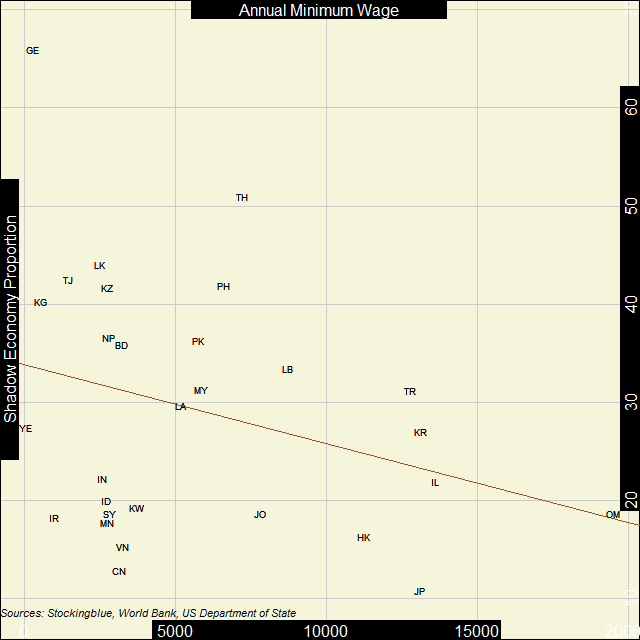
In Asia, the inverse correlation between the strength of the shadow economy and the minimum wage is very weak. There is no real relationship between the strength of the shadow economy and minimum wage.
Findings
- The correlation coefficient between per capita Gross Domestic Product (GDP) in Purchasing Power Parity (PPP) and minimum wage in Asia is -0.31.
- As the shadow economy increases in the continent, the minimum wage does not necessarily decrease.
- Japan has the weakest shadow economy and the fourth highest minimum wage.
- Oman has the seventh weakest shadow economy and the highest minimum wage.
- Albania has the lowest minimum wage and third strongest shadow economy.
- Georgia has the second lowest minimum wage and the strongest shadow economy.
- Yemen has the lowest minimum wage and the 15th weakest shadow economy.
- Only Thailand and Georgia have shadow economy that takes up more than half of their overall economy.
Caveats
- As always, correlation does not imply causation.
- The United Arab Emirates, Afghanistan, Armenia, Azerbaijan, Bahrain, Bhutan, Cyprus, Iraq, Cambodia, North Korea, Myanmar, Macao, Maldives, Palestine, Qatar, Saudi Arabia, Singapore, Timor-Leste, Turkmenistan, Taiwan, and Uzbekistan were missing data.
- Minimum wages sometimes vary by profession and other variables.
Details
Just like in Europe, there is a loose geographic association. However, the geographic association is not as strong as it is in Europe. The obvious geographic clusters include the former Soviet republics which tend to have strong shadow economies and low minimum wages, South Asian countries which tend to have weak shadow economies and low minimum wages, East Asian countries and countries from the Levant that tend to have weak shadow economies and high minimum wages, and finally there is a loose cluster of Southeast Asian countries that range from weak to strong shadow economies that tend to have moderate minimum wages.
Unlike Europe however, there is no correlation between the strength of a shadow economy and the minimum wage.
Country Codes
| Code | Country | Annual Minimum Wage | Shadow Economy (as Percentage of GDP) |
|---|---|---|---|
| BD | Bangladesh | 3,235 | 35.9 |
| CN | China | 3,139 | 12.9 |
| GE | Georgia | 284 | 66.0 |
| HK | Hong Kong | 11,248 | 16.3 |
| ID | Indonesia | 2,707 | 19.3 |
| IL | Israel | 13,608 | 21.9 |
| IN | India | 2,590 | 22.3 |
| IR | Iran | 994 | 18.3 |
| JO | Jordan | 7,795 | 18.7 |
| JP | Japan | 13,088 | 10.8 |
| KG | Kyrgyzstan | 558 | 40.3 |
| KR | South Korea | 13,140 | 27.0 |
| KW | Kuwait | 3,733 | 19.3 |
| KZ | Kazakhstan | 2,730 | 41.7 |
| LA | Laos | 5,193 | 29.7 |
| LB | Lebanon | 8,722 | 33.5 |
| LK | Sri Lanka | 2,499 | 44.1 |
| MN | Mongolia | 2,755 | 17.8 |
| MY | Malaysia | 5,840 | 31.3 |
| NP | Nepal | 2,815 | 36.6 |
| OM | Oman | 19,506 | 18.7 |
| PH | Philippines | 6,623 | 41.9 |
| PK | Pakistan | 5,748 | 36.3 |
| SY | Syria | 2,850 | 18.9 |
| TH | Thailand | 7,223 | 51.0 |
| TJ | Tajikistan | 1,444 | 42.5 |
| TR | Turkey | 12,779 | 31.2 |
| VN | Vietnam | 3,259 | 15.3 |
| YE | Yemen | 48 | 27.4 |
Sources
US Department of State. 2017. "Country Reports on Human Rights Practices for 2016." Accessed September 2, 2017. https://www.state.gov/j/drl/rls/hrrpt/humanrightsreport/index.htm#wrapper.
Schneider, Friedrich, Andreas Buehn, and Claudio E. Montenegro. 2010. "Shadow Economies All over the World: New Estimates for 162 Countries from 1999 to 2007." The World Bank Development Research Group.